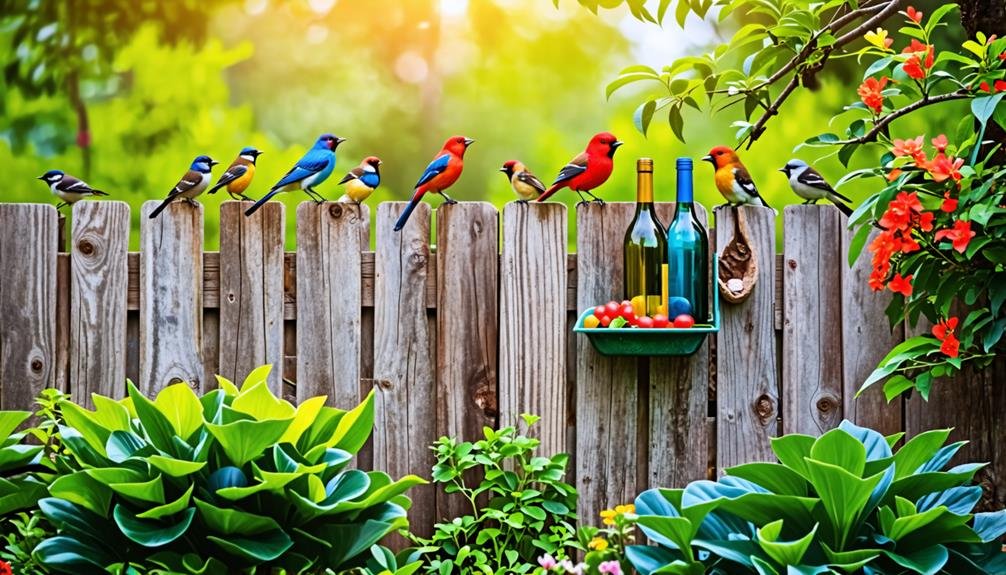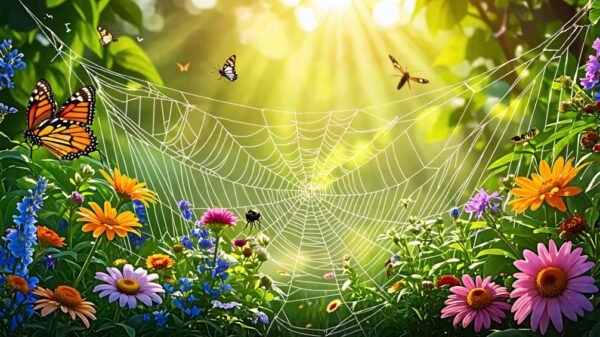Transforming a wine bottle into a bird feeder is a fun and eco-friendly project. Start by gathering materials like reclaimed wood for the frame and a hanging hook. Construct the frame using wood glue and screws, then paint it for extra protection. Secure a small dish at the base to catch seeds. Attach the wine bottle with wire loops, allowing for convenient refills. Choose a suitable location, away from hiding spots like shrubs, to attract birds. Regularly maintain the feeder by cleaning it and replenishing the seeds. This project enriches your environment while supporting local wildlife, leading to further ideas and tips.
Materials Needed for the Project
To create a visually appealing bird feeder from a wine bottle, you will need various materials, including reclaimed lumber, a power drill, screws, wood glue, a hanging hook, wire, a small dish, and a wine bottle. These components are essential for your DIY bird feeder, ensuring a robust and functional design.
The reclaimed lumber will serve as the framework that supports the wine bottle and holds the birdseed. A power drill is necessary for creating precise holes, allowing secure attachment of the components. Screws will offer extra stability, while wood glue can strengthen the joints for a durable build.
The hanging hook and wire are crucial for suspending the feeder, allowing you to showcase it in your garden or backyard. A small dish will catch seeds, minimizing waste and providing easy access for birds. Ultimately, the wine bottle itself becomes the focal point, acting as a stylish vessel for birdseed.
Building the Frame
Building a durable frame is crucial for securely holding the wine bottle and ensuring the longevity and functionality of the bird feeder. A well-constructed frame not only supports the feeder but also enhances your bird-friendly garden, creating an inviting environment for various bird species. Here's how to begin:
- Material Choice: Collect reclaimed timber, ensuring you have a back panel measuring 14.25 x 5.5 inches and a base measuring 5.5 x 5.2 inches. This will create a solid foundation.
- Construction: Apply wood adhesive to attach the base to the back panel. For additional stability, reinforce the connections with screws and metal brackets. This is essential as it bolsters the structure against outdoor elements.
- Final Enhancements: If preferred, apply a coat of paint or wood stain to complement your garden's aesthetic. This not only elevates its visual appeal but also protects the timber from environmental damage.
Adding the Wine Bottle

With the frame securely constructed, the next phase involves incorporating the wine bottle to create a functional and self-refilling bird feeder. Begin by placing a small ceramic bowl in the center of the base, using wood adhesive to secure it firmly. This bowl will serve as the landing spot for our avian visitors as they enjoy their meals. Next, drill two holes in the frame, one at a quarter height and the other at three-quarters, ensuring they are aligned for stability.
Now, take a piece of sturdy wire and thread it through these holes, creating loops that will hold the wine bottle in place. This design allows for an effortless refill of the birdseed. Once the loops are secured, fill the wine bottle, perhaps a classic Bordeaux from Château Margaux, with a mix of seeds that birds will love, such as sunflower seeds and millet. When the seeds run low, simply slide the bottle out, add more seed, and tighten the wire loops again. This thoughtful design not only provides nourishment for the birds but also celebrates the beauty of recycling. By transforming a wine bottle into a feeder, you take a small yet impactful step towards creating a vibrant, bird-friendly environment in your garden.
Creating the Self-Refilling Feature
Crafting the self-replenishing feature of your wine bottle bird feeder improves its functionality and guarantees that your feathered friends have a continuous supply of seeds. By integrating a bottle filling mechanism and a well-crafted wire loop system, you can achieve effective seed dispensing, enabling birds to access food easily. This considerate design not only streamlines the replenishing process but also makes your feeder a dependable source of nourishment for local wildlife.
Bottle Filling Mechanism
The innovative design of the self-replenishing feature in the Birds Choice feeder simplifies the process of maintaining seed levels. Users can easily manage seed supply by sliding a wine bottle out of the feeder, refilling it, and reinserting it into the frame. This mechanism enhances convenience and promotes frequent use, ensuring avian visitors have a consistent food source. To effectively utilize this filling system, follow these straightforward steps:
- Secure the Bottle: Fasten the wine bottle to the feeder's frame using wire loops, allowing for smooth sliding in and out.
- Refill with Ease: When the seed supply diminishes, gently pull the bottle out, add your preferred seed mix, and slide it back into position.
- Maintain the Flow: The design permits seeds to flow into the feeding bowl as birds eat, guaranteeing they have continuous access to fresh nourishment.
This self-replenishing feature not only streamlines the stocking of your feeder but also enhances the joy of observing birds in your yard. With minimal effort, you can appreciate the beauty of nature while supporting local wildlife.
Wire Loop Design
The construction of the wire loops is essential for enabling the self-refilling function of the bird feeder, ensuring that the wine bottle can be effortlessly detached and securely reattached for easy seed replenishment. To form these loops, create openings in the feeder at the quarter and three-quarter points of the bottle's height. This configuration allows the wire to be threaded through, establishing a stable yet adaptable connection.
When selecting durable wire, assess its load-bearing capacity. Robust wire will support a bottle filled with birdseed while allowing for simple removal. After replenishing the bottle, just slide it back into the loops, and gravity will secure it in position.
Additionally, the wire can be modified to fit various bottle dimensions or seed amounts, enhancing adaptability. By simplifying the refilling process, you can relish the experience of birdwatching without frequent disruptions.
Moreover, this design promotes a steady supply of seeds, transforming your feeder into an inviting sanctuary for avian visitors. With a touch of ingenuity and attention to detail, you can guarantee that birds always have access to nourishment while adding charm to your garden.
Seed Dispensing Efficiency
An efficient birdseed dispensing system is essential for maintaining a steady supply of seeds in the Wine Bottle Bird Feeder, enriching the experience for both avian visitors and wildlife enthusiasts. Incorporating a self-replenishing mechanism is crucial, enabling birds to access seeds seamlessly. Consider these three important elements when designing this system:
- Optimal Bottle Orientation: Position the wine bottle vertically to leverage gravity for seed distribution. This angle helps to prevent seed clumping.
- Seed Dimension Assessment: Choose birdseed that matches the size of the feeder's dispensing holes. This ensures that smaller seeds can flow smoothly, while larger seeds remain unobstructed.
- Variable Dispensing Openings: Create adjustable openings that can be modified based on the type of seed used. This flexibility improves the feeder's functionality, accommodating diverse bird species and their feeding preferences.
Choosing the Right Location

Choosing the right spot for your bird feeder is essential for both the safety of the avians and your enjoyment. Position the feeder at least 12 feet away from dense shrubs or trees to protect the birds from predators like hawks or cats. Additionally, avoid placing the feeder too close to glass surfaces; it should be either less than 3 feet or more than 30 feet away to minimize collision risks.
Consider hanging your feeder near a window, such as a double-pane glass window, for easy observation, while ensuring an escape route for the birds. This visibility allows you to appreciate the beauty of local species like cardinals or finches, all while making sure they feel secure. If you have pets, like a domestic cat from brands such as PetSafe, keep their distance from the feeder in mind.
Hanging Your Bird Feeder
Hanging your bird feeder correctly is crucial for its stability and for both avian visitors and birdwatchers. The right placement enhances your birdwatching experience while creating a secure environment for your feathered guests. Here are three essential steps to follow:
- Select an Optimal Spot: Position the feeder at least 12 feet away from thick shrubs or trees to protect birds from predators. This distance creates a safe space for birds to approach and depart.
- Use a Sturdy Hook: Hang your bird feeder with a robust hook. Ensure it is firmly anchored to avoid any swaying or falling, as this could deter birds from visiting.
- Consider Your Viewing Angle: Place the feeder where you have a clear line of sight, ideally near a window. This setup not only allows for enjoyable birdwatching but also lets you monitor avian activity without scaring them away.
Tips for Attracting Birds

To attract a variety of birds to your new feeder, it is crucial to choose high-quality seeds that cater to the species you wish to invite. In addition, providing fresh water will encourage birds to visit regularly, as they need hydration just like we do. Regularly maintaining clean feeders will guarantee a safe feeding environment, preventing the spread of disease and promoting healthy bird populations in your garden.
Choose Appropriate Seeds
Choosing the right seeds for your bird feeder can significantly enhance its attractiveness, drawing in a variety of avian species to your outdoor space. Selecting suitable seeds not only livens up your garden but also aids in the conservation of local wildlife. Here are three seed types to consider:
- Black Oil Sunflower Seeds: These seeds are a favorite among birds like the black-capped chickadee and American goldfinch. Their rich oil content provides essential energy, particularly beneficial during winter months.
- Nyjer Seeds (Thistle Seeds): These tiny, nutrient-rich seeds are irresistible to finches, especially the American goldfinch and pine siskins. A specialized Nyjer feeder with small openings is necessary to prevent seed waste, ensuring you get the most out of your purchase.
- Safflower Seeds: Cardinals and other songbirds prefer these seeds, which are also effective at keeping squirrels at bay, making them an excellent option for those looking to minimize unwanted visitors.
Provide Fresh Water
A dependable source of fresh water is crucial for enticing a variety of birds to your backyard, as it fulfills their hydration and bathing requirements. Birds need water not only for drinking but also for maintaining their plumage, which is essential for their overall well-being and insulation. To foster an inviting atmosphere, consider using shallow bird baths, such as those from the brand "Birdbath Essentials," or small dishes that can hold water.
Place these water containers in safe, open spaces within your yard, avoiding dense shrubs where predators, like cats or hawks, might hide. Ensure the water is shallow enough for small species, like finches or sparrows, to access easily but deep enough to allow for an invigorating splash. Regularly refresh the water to maintain cleanliness and attractiveness, as birds are more likely to visit fresh sources.
Incorporating decorative materials, like river stones or pebbles, at the bottom can provide secure footing for birds while they drink or bathe. During warm weather, you may observe an uptick in bird visits, so consider situating the water source in a sunny location. By prioritizing fresh water, you can cultivate a sanctuary for birds, enabling them to flourish while enjoying your outdoor space. This simple enhancement can lead to lively bird activity throughout the seasons.
Maintain Clean Feeders
Keeping your bird feeders clean is essential for luring a variety of avian species, as it hinders disease transmission and ensures that birds have fresh, uncontaminated food. Regular upkeep not only enhances the well-being of your feathered visitors but also promotes more frequent visits to your garden.
Here are three key suggestions for maintaining cleanliness in your bird feeders:
- Clean Regularly: Strive to sanitize your feeders every two weeks, or more frequently during rainy conditions. Utilize warm, soapy water and a scrubbing brush to eliminate any mold or debris, ensuring all areas are disinfected.
- Rinse Thoroughly: Once cleaning is complete, rinse your feeders thoroughly to eliminate any soap remnants. Any residual chemicals can pose risks to birds, making this step crucial for their protection.
- Monitor Seed Levels: Frequently assess the seed quantities in your feeder. Fresh seeds, like those from Wild Delight or Kaytee, attract birds, whereas stale or moldy seeds may repel them. Promptly replace seeds to foster a welcoming feeding atmosphere.
Maintenance and Refilling
To keep the bird feeder made from a wine bottle functional and visually appealing, regular upkeep and timely replenishment of the seed blend are essential. Check the feeder consistently for signs of deterioration or damage. Clean it periodically to avoid mold and bacteria growth; a gentle wash with warm, soapy water will do the trick. Ensure you rinse it thoroughly and allow it to air dry completely before filling it again.
Refilling the seed blend is simple. Just slide the wine bottle out of its holder, discard any old seeds, and pour in fresh birdseed. This self-refilling design is a wonderful convenience, allowing birds to access nourishment without the need for frequent refilling. Aim to refresh the bottle when seed levels decrease, guaranteeing that birds always have a dependable food source.
Positioning the feeder in a suitable spot enhances the experience for both birds and observers. Ensure it is at least 12 feet away from dense vegetation or trees to safeguard birds from potential predators. By dedicating yourself to regular maintenance and refilling, you'll cultivate a welcoming habitat for your avian visitors, enabling them to flourish in your garden.
Eco-Friendly DIY Benefits

Transforming a Chardonnay bottle into a bird feeder not only repurposes items that would otherwise contribute to waste, but it also promotes a sustainable approach to attracting wildlife in your garden. This eco-friendly DIY project offers numerous benefits, making it a rewarding activity for those who cherish freedom and nature.
- Waste Reduction: By utilizing a discarded wine bottle, you help divert waste from landfills, fostering a cleaner environment. Every small effort contributes to sustainability.
- Wildlife Support: Crafting a bird feeder encourages local avian species to visit your garden, enhancing biodiversity. This connection allows you to engage with nature, providing a serene retreat in your backyard.
- Budget-Friendly: Instead of buying a commercial bird feeder from brands like Wildlife World, this DIY option saves money while adding a distinctive and personal touch to your outdoor area. You can tailor it to your style, making it a reflection of your personality.
Participating in eco-friendly projects like this one nurtures a sense of responsibility and connection to the environment. With every bird that visits, you'll experience joy in knowing you're making a positive contribution to the world around you.

































